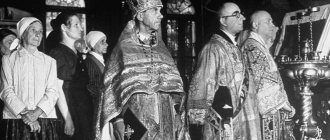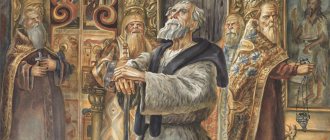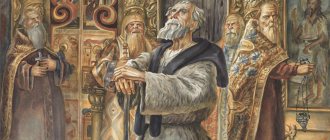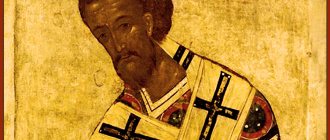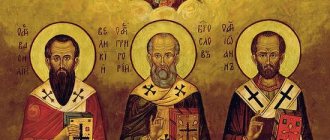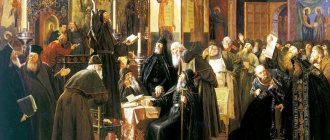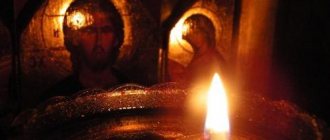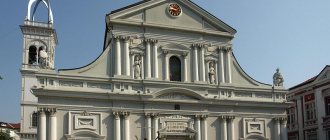4.1
Average rating: 4.1
Total ratings received: 117.
4.1
Average rating: 4.1
Total ratings received: 117.
The division of the Christian Church into Catholic and Orthodox went down in history as the “great schism.” This event took place in 1054. Since then, there have been two directions in Christianity, eastern (patriarchs) and western (Pope).
What is schism
A schism is understood as something more than a quarrel between individual believers within one denomination. We are talking about the cessation of prayerful and Eucharistic communion between the Local Churches. The reasons for it may be dogmatic inconsistencies, the desire for greater political power, personal ambitions, serious ritual and cultural differences, as well as discord between the leaders of the Churches.
The history of the Church knows several examples of schisms so serious that they led to the destruction of unity between Christians for many centuries.
In what year did the Great Schism occur?
The most famous church schism in world history dates back to 1054.
Harbingers of the schism of the Christian Church
The separation of Christianity into Western and Eastern became an almost foregone conclusion. It is too closely intertwined with Roman government structures.
After the formation of two balanced political centers, maintaining the unity of the Roman Empire was extremely difficult. The situation worsened after in 476 .
The rulers of the Eastern part of the state considered themselves the heirs of the Eternal City not only politically, but also spiritually. Constantinople began to be called the Second Rome - the new capital of world Christianity.
St. Peter's Basilica in Rome today
However, the Roman hierarchs did not even think of giving up their primacy for influence in the Church. They considered the pope, the head of all Catholics, to be the successor of Peter, the disciple of Jesus, who preached the Gospel and met martyrdom in this city. It followed that it was the clergy of Rome that should have the highest status among all the shepherds of the world Christian assembly.
The tragic development of the idea of the primacy of the pope becomes irreversible from the very moment when it begins to claim the place of mandatory dogmas of faith. This is how the heresy of the papacy appears. With the help of such a “dogma” the papacy almost completely distorts the truth revealed to us in Christ. This dogma especially hits the Church. After all, this way her direct connection as a “body” with her head is abolished, i.e. By Jesus Christ , one bishop (the pope) wants to stand at the head of the body, at the head of everything. Thus, not only the Council and all the bishops, but also the Church itself becomes the body of the pope, because without him it ceases to be true, it cannot save a person.
Professor Farandos
Until a certain time, Constantinople did not seem to notice the popes' claims to a dominant position in the Church. But this desire for supreme power set in motion a time bomb that one day exploded, destroying the unity of the believers.
Hagia Sophia was built by Emperor Justinian I in Constantinople (now Istanbul) in 532-537 on the site of burnt Christian churches built in the 4th and 5th centuries under the emperors Constantine I and Theodosius II. It was the largest Christian church in the world until 1626, the date of completion of St. Peter's Basilica in Rome. The official name today is the Great Mosque of Hagia Sophia.
Results and consequences
In July 1054, representatives of the Roman Church went to the altar of St. Sophia Cathedral and began to denounce the holy Patriarch Michael of unrighteousness right during his divine service. And then they announced that the Eastern Patriarch was excommunicated from the church along with his followers, accusing him, in the process, of heresy.
The Patriarch was speechless with amazement. The people present also did not immediately recover from the shock, but, having come to their senses, they supported their ruler. Strong unrest arose, and representatives of Rome had to urgently leave Constantinople.
In turn, Cerularius also soon convened his Council, where he anathematized the papal supporters. This is how the Great Schism happened.
This is truly true: the West is the West - the East is the East: they will never be together.
Accordingly, the eastern patriarchates remained with Byzantium, the western with Rome. Since then, the Eastern Church began to be called Orthodox, the Western - Catholic.
Reasons for church schism
By the middle of the 11th century, the Greek and Latin Churches had accumulated many complex questions and differences of opinion towards each other. The reasons for the fragmentation were:
- Disputes about the status of the Pope. Who should consider him: the head of Christian churches around the world or the first among equal bishops?
- Disagreement over the filioque - the Catholic aspect of the doctrine of the Trinity, according to which the Holy Spirit does not come from God the Father alone, but also from the Son. Since ancient times, Christian theologians believed that the Holy Spirit can only come from the Father. This dogma was approved by the Ecumenical Council at a time when the Church was united.
- The coronation of the Emperor of New Rome Charlemagne by the Pope, which spoke of the extraordinary political ambitions of the Latin Church.
- In the Latin Church, unleavened bread could be used to celebrate the Eucharist, while in the Greek they used bread baked with sourdough.
- Different attitudes towards marriage among clergy. Greek pastors were allowed to marry, while Latin pastors were required to remain celibate.
- Western Christians fasted weekly on the Sabbath, but Eastern Christians did not.
Interesting fact
64th Rule of St. of the Apostles says: “If anyone from the clergy is found fasting on the Lord’s Day, or on Saturday, except one only (Great Saturday), let him be cast out.” The Sixth Ecumenical Council, by its 55th canon, decided that the 64th canon of St. should also be fulfilled in the Roman Church (i.e., among future Catholics). Apostles, prohibiting fasting on Saturday. “Having learned of the Holy Council,” writes the interpreter of the conciliar rules, “that in the Roman city they are violating the 64th rule of the holy apostles, which commands not to fast on other Saturdays except Holy Saturday, it commanded that such apostolic rule should remain unchanged in the Roman Church.”
First schism - Novatian
Novatianism is the name given to the society of schismatics of the 3rd–7th centuries. Novatian became its leader . He opposed the Roman Bishop Cornelius and the Carthaginian Bishop Cyprian, who accepted back into the fold of the Church those who renounced Christ during times of terrible persecution, but then repented.
The Novatians were convinced that the Church should consist only of holy people. Therefore, all who have fallen spiritually and morally and committed mortal sin should be expelled from the Christian congregation without the right of return. The schismatics formally separated from the Church of Rome. Their position led to the first schism in church history.
Akakian schism
This schism occurred in 484 and remained in force for 35 years. Its participants were the Churches of Rome and Constantinople.
After the IV Ecumenical Council in Chalcedon ended, a long period of unrest began. The monks, who were Monophysites, expelled from Alexandria, Jerusalem and Antioch the bishops who accepted the decisions of the council held in Chalcedon. Emperor Zeno and the head of the Church of Constantinople, Acacius, made efforts to preserve the unity of believers and harmony in the state. They tried to reconcile the Monophysites with the Church.
But Pope Felix II opposed their decision and turned to Acacius with a demand to appear at a meeting of the council in Rome and explain himself about the document that he, together with the emperor, was distributing to meetings.
Akaki refused and even tried to bribe the pope's envoys, so in 484 Felix II excommunicated the patriarch from the Church. He did not remain in debt and excommunicated dad. In 519, their decisions were reversed by the 52nd Pope Hormizd and Patriarch John II of Constantinople.
Background to the Great Schism
Thus, the so-called Acacian schism (484-519) lasted for 35 years, which arose due to religious discrepancies in the Henotikon, a special religious message that the Byzantine emperor Zeno sent to believers with a call to unite and stop conflicting. However, some people thought differently from the fathers mentioned in the Henotikon...
Further, from 863 to 867, the next Photius schism lasted between the Roman Papacy and the Patriarchate of Constantinople, which arose as a result of an ambiguous interpretation of the legality of the accession to the throne of Patriarch Photius...
And when the Christian Church began to transform from a persecuted sect into a rich and prosperous religious system, the disagreements between its parishioners not only did not disappear, but only multiplied many times over.
Witnesses of the great schism of 1054
In 1054, Pope Leo IX decided to improve relations with Constantinople, whose patriarch Michael Cyrularius actively opposed Western Christian efforts to subjugate the Eastern Church to Western theocracy. A year earlier, in the capital of the Byzantine Empire, all church buildings where services were performed according to the Catholic model were closed.
The leadership of the papal embassy was entrusted to Cardinal Humbert Silva-Candida. Arriving in Constantinople, he persuaded Emperor Constantine Monomakh to depose the patriarch, with whom he did not even deign to talk. The emperor refused to grant the cardinal's request, but he still - right at the service - presented the patriarch with a papal letter of excommunication.
Michael responded by convening a council, at which three papal legates were anathematized. This is how the fragmentation that is called the Great Schism happened. Unfortunately, it has not yet been completely overcome.
Interesting fact
The ancient Greeks used the word "schism" for the operation of splitting a walnut.
Papal ambitions and the last reason for the schism
So, returning to the beginning of our story, let me remind you that the final reason for this was the conflict between the high priests: the Roman, Pope Leo the Ninth and the Byzantine: Patriarch of Constantinople Michael Cerullarius.
The Pope insisted that the Roman see was paramount and should be respected without complaint as a mother. However, Michael did not think so, believing that the see of Constantinople was by no means less important. Since this all started. Or rather, that’s how it all ended.
In the spring of 1054 Cardinal Humbert, who arrived as ambassador to Constantinople from Rome, was unable to cope with the mission entrusted to him. (And one of the points included reconciliation with Mikhail).
His unbridled temper and some, as sources testify, impudence led to the fact that the high-ranking people finally quarreled.
Schism within the Catholic Church
The beginning of the Reformation - the Catholic schism - dates back to October 31, 1517, when Martin Luther protested against indulgences. He just demanded changes, a return of Christian teaching to the apostolic version, and as a result a new religion appeared.
Martin Luther at the Worms Reichstag
Originating in Germany, Protestantism “infected” other kingdoms. Thus the religious unity of Europe was destroyed.
The Roman Church did not suit the reformers for a number of reasons:
- it did not recognize the national independence of Western European states;
- proclaimed the power of the pope above the royal one;
- traded indulgences and church positions, demanded tithes;
- did not stop the unchristian behavior of the clergy.
Radical changes were accompanied by religious wars and peasant uprisings. The Reformation ended with the signing of the Peace of Westphalia in 1648.
From 1378 to 1417, Catholics had several popes at once: first two, and in 1409 there were four. They were all replaced by Martin V at the Ecumenical Council of 1414–1418. This is almost the end of the split.
Christian denominations. Scheme
Arianism - the heresy of barbarians
Theological disputes, which quickly became political problems, began in the era of relative stability of the Roman Empire. Religious problems were closely intertwined with the political situation. Such crises were the splits associated with the emergence of the movements of Arianism and Donatism.
One of the first was associated with the name of the Alexandrian cleric Arius, who preached in Alexandria in the 4th century. He tried to clarify the rather vague dogma of the Trinity, introducing some hierarchy into it - for example, he argued that since Jesus Christ was the son of God, that is, his creation, he could not be considered equal to his father. This led to doubts about the divine motherhood of Mary and the postulate of salvation, which seriously damaged the basis of the religious system.
Emperor Constantine, who proclaimed Christianity as the official imperial religion, was reasonably wary of such ideas. In 325, he convened the Nicene Church Council, at which, in addition to adopting the creeds that exist today, Arian's teaching was condemned and his theological works were burned. “I think,” said Konstantin. - more terrible than any war and terrible battle is internal discord in the assembly of God. Nevertheless, the influence of Arianism was so strong that the emperor reconsidered his decision and soon returned the convicted clerics from exile. In 341, at the Council of Antioch, this movement actually became dominant in Christianity. However, already during the reign of Theodosius I, Arianism was finally condemned at the official level. Despite this, it spread widely among the barbarian peoples living on the borders of the empire, and the first barbarian kingdoms that formed after the collapse of the Western Roman Empire professed the Arian version of Christianity for a long time.
Mosaic of the Arian Baptistery in Ravenna. Source: wikipedia.org
First Crusade
The campaign began in 1096. At the Council of Clermont, Pope Urban III called on believers to liberate Christian territories occupied by Muslims. Mostly the poor took part in the campaign, led by Peter of Amiens . In 1096 they arrived in Constantinople and, without waiting for the knights, went to Asia Minor, where they were defeated by Turkish troops.
The following year, more than 300,000 crusader knights set out on the campaign. They took the fortress of the city of Nicaea, Antioch. In 1099 Jerusalem was taken. On the conquered lands, Europeans founded new states, for the protection of which knightly orders were created.
Overcoming the split
They tried more than once to overcome the Church schism between Orthodox and Catholics:
- In 1274, Christians entered into a union under the leadership of Pope Gregory . The Orthodox gave primacy to him and his future successors, and also agreed with most of the Catholic dogmas. However, already in 1285 this union was condemned.
- A similar union was concluded in 1438 at a council convened by Pope Eugenius IV . The Greek church leadership condemned her too.
The Russian Orthodox Church also made efforts to eliminate the schism among Christians both in our country and at the international level. At the moment, the division between the Old Believers and the Russian Orthodox Church is being healed by the efforts of both sides. In relations with Catholics, the leadership of Orthodoxy stands on a position of respect.
The ecclesiastical position of those who separated cannot be clearly defined. In the divided Christian world, there are some signs that unite it: this is the Word of God, faith in Christ as God and Savior who came in the flesh (1 John 1, 1-2; 4, 2, 9), and sincere piety.
The existence of various rites of worship (through Baptism, through Confirmation, through Repentance) shows that the Orthodox Church approaches heterodox confessions in a differentiated manner. The criterion is the degree of preservation of the faith and structure of the Church and the norms of spiritual Christian life. But, establishing various rites of worship, the Orthodox Church does not pass judgment on the extent to which grace-filled life is preserved or damaged in heterodoxy, considering this a secret of God’s Providence and judgment.
Decision of the Jubilee Council of Bishops in 2000
Donatists - North African fanatics
Even before the official Christianization of the Roman Empire, the church experienced a serious schism, called Donatist after the Numidian bishop Donatus. The reason for the disagreement between North African churchmen and Roman clergy was the behavior of some clergy during the persecution of believers during the reign of Diocletian. The Donatists condemned their colleagues for collaborating with the authorities in order to save their lives. For them, martyrdom became the main virtue of a Christian, and the sacraments, based on this, could only be performed by a person who belongs to the church. The very criterion of belonging came from righteousness.
"The Last Prayer of the Christian Martyrs." Jean-Leon Gerome. Source: wikipedia.org
Constantine tried to reason with the Donatists, who did not want to make contact with the official church. These attempts failed each time, so in 321, by a special edict, the emperor granted the apostates freedom of faith and the administration of the sacraments. However, already under Constantine’s successor, Constans, persecution resumed, to which the Donatists responded with an uprising: together with dissatisfied peasants and runaway slaves, they robbed and killed the “wicked” and did their best to become martyrs and endure torture for their faith. The suppression of this speech cooled the ardor of the fanatics for some time, and under Julian the Apostate they again began to enjoy freedom of religion.
Julian the Apostate. Source: wikipedia.org
At the end of the 4th century, the Donatists actively participated in various uprisings against Rome, and not a single significant civil schism could have happened without them. However, during its existence, the movement was divided into small groups, often intensely competing with each other. The Donatists were finally defeated at the Council of Carthage in 411, where the Bishop of Hippo Augustine, who soon went down in history as Augustine the Blessed, spoke out against them. The theological dispute with the apostates ended in his favor and convinced Emperor Honorius to continue the persecution of the sect. Nevertheless, many of the Donatists held out for several more centuries after this, until North Africa was conquered by the Arabs. And in the history of the church, the name of this movement already appeared in the polemical literature of the Reformation era - this is how opponents of the teachings of Luther and Calvin “called” their opponents in endless theological disputes.
Mutual anathemas and their removal
Unfortunately, the gap between the Orthodox and Catholic worlds stretched not for decades, but for centuries. It has not yet been overcome. In 1964, Patriarch Athenagoras, head of the Orthodox Church of Constantinople, met with the head of the Catholics, Paul VI.
December 7, 1965 Meeting of Patriarch Athenagoras and Pope Paul VI
Thanks to this, at the end of 1965 they signed a joint declaration on lifting mutual anathemas. Alas, it turned out to be a formal document, not confirmed by significant cases.
“In our opinion, this act does not have theological significance for the entire Fullness of the Holy Orthodox Church.”
Patriarch Alexy I
Photius schism: patriarch versus pope
In 863, the Pope and the Patriarch of Constantinople again found a reason to break off relations. However, this time the situation was more serious - both pontiffs anathematized each other. Pope Nicholas I and Patriarch Photius initiated the next major schism in the Christian Church, called the Photius schism.
By this time, a sufficient number of differences in theological issues between the West and the East had accumulated. Photius, who was elected Patriarch of Constantinople in 857 and who had previously had nothing to do with the church (his appointment was caused by the internal political struggle in Byzantium), seriously criticized Western liturgies, the Roman interpretation of the Holy Trinity and opposed celibacy. Political disagreements were added to theological disputes: the Bulgarian Tsar Boris I, having been baptized according to the Byzantine model, sought an alliance with Rome.
The schism ended immediately after the removal of Photius from the post of patriarch after another coup d'etat in Byzantium. At the Fourth Council of Constantinople, the new head of the Byzantine church, Ignatius, and Pope Nicholas I condemned the teachings of the deposed cleric and announced the reunification of churches, but Rome was forced to recognize Bulgaria as part of the sphere of influence of the Eastern Roman Empire.
Interrogation of Photius. Illustration from the manuscript “Review of History.” (wikimedia.org)
Photius regained his patriarchate after the death of Ignatius, but there was no longer any talk of hostility with the papacy. At the Council of St. Sophia in 879, the cleric's good name was restored.
Schism of the Orthodox Church
In the 1650s–60s, a serious church schism occurred in Russia. It was provoked by the religious reforms of Patriarch Nikon .
Nikon, Patriarch of Moscow
Briefly about Nikon's reform and the split in the Russian Orthodox Church
The split is a consequence:
- errors accumulated in liturgical books;
- lack of unity in the conduct of church rituals, the creation of icons, the formation of statutes, etc.
Nikon was guided by liturgical texts and practices of the Greek model of that time. Unfortunately, he preferred not to explain to believers who disagreed with him the reasons why he made certain decisions, but resorted to his authority and the support of the Russian Tsar. The patriarch had a very proud and domineering character.
Church Council of 1654 (Patriarch Nikon presents new liturgical texts) A. D. Kivshenko, 1880
In 1654, at the Council of Hierarchs, a decision was made to reform liturgical texts. In 1656, the sign of the cross made with two fingers was declared heresy. All who did not agree to cross themselves with three fingers were sentenced to anathema.
Because of the intolerance of the patriarch, society split. Many people, including representatives of the nobility, rebelled against Nikon's reforms. Some monasteries declared disobedience to the authorities.
Not the least role in the schism was played by Archpriest Avvakum , the parish priest who became the leader of those opposed to change. He bombarded the tsar with complaints about his fellow countryman Nikon (they were both from the Nizhny Novgorod province) and denounced him publicly. For this, the zealot of antiquity and ancient Russian religious literature was exiled several times to Siberia and Transbaikalia, then cut off his hair.
Fragment of the painting by P. E. Myasoedov “The Burning of Archpriest Avvakum”
The cruel trials, however, did not break him. He continued to preach and denounce Nikonianism until Tsar Fyodor Alekseevich sentenced the rebel and three of his comrades to be burned alive.
After which some of their followers traveled to cities and villages and proclaimed that the Antichrist had appeared in the world. It is terrible that they called for self-immolation as a means of cleansing the soul. As a result, many gullible people died.
After the death of Avvakum, there was a final demarcation between Old Believer and Reformed Orthodoxy in Rus'. The attempt of Metropolitan Platon (Levshin) to introduce common faith in the 19th century failed.
In 1971, the Russian Orthodox Church recognized the old and new rituals as equally saving.
Metropolitan Korniliy (Titov ) Bishop of the Russian Orthodox Old Believer Church:
We would like to overcome disagreements through the revival of pre-schism Orthodoxy, but when and how this will happen is known only to God.
Boyarina Morozova, Archpriest Avvakum and other opponents of Nikon’s reform... All the details are in the article:
- Church schism in the Russian Orthodox Church. Causes and consequences
Defeat of the Catholic World
The events of the 16th century can be considered the largest schism in the history of the Catholic world. The crisis of the church organization was obvious - this was also shown by the schisms of the past, the causes of which were often the same factors. However, the Reformation became a truly large-scale movement, which at the right time also received political support.
[Collection: Reformation]
Beginning with the sermons of Martin Luther in Germany, Ulrich Zwingli and John Calvin in Switzerland, a wave of dissatisfaction with the situation in the Catholic Church literally swept across Europe and led to far-reaching consequences.
Sermon by Ulrich Zwingli. (wikipedia.org)
New religious trends reached almost all Christian countries in Europe. Germany was divided into two leagues, and clashes between Catholics and Protestants constantly took place on its territory. Spontaneous uprisings of the third estate arose there every now and then. England began reforms “from above” - this is how Anglicanism appeared. All countries of the Scandinavian Peninsula, including Finland, switched to Protestantism.
[Collection: Reformation in England]
In Europe, two opposing camps began to take shape - in 1618 this would lead to the bloody Thirty Years' War, which swept through Germany like a tornado and turned most of its territory into a scorched desert.
Map of the Reformation in Europe. (rusidea.org)
However, there was no unity among Protestants either. From the very beginning, in addition to the evangelists and Calvinists, who made up the overwhelming majority of those who disagreed with the Catholic Church, a scattering of smaller movements appeared. Baptists, Mennonites, Quakers, Presbyterians, Methodists, Pentecostals - their number tends to infinity. The prerequisites for such a situation were laid at the beginning of the Reformation by Protestant theologians themselves: by advocating for individual freedom in matters of religion, they prepared the ground for the rapid division of believers into groups, and the differences could relate to completely insignificant issues.
[Collection: Religious Wars]
Historical significance of the schism of the Christian Church
The split has several important consequences:
- Formation of two points of view on serving God and Christian history.
- Orthodoxy has preserved the principle of independence of local Churches, which has made it possible to create original theological works within the framework of a single Christian teaching.
- The worldwide preaching of the Gospel was greatly damaged. Many people began to perceive the Christian Churches as political parties that use the spiritual needs of people and religion in general as a means to achieve selfish interests.
